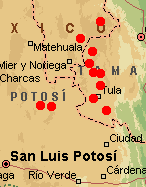
Range of Pinus nelsonii (3). Basemap from Expedia Maps .
Common Names
Nelson piñon (2).Taxonomic notes
A highly distinct endemic with several unique features and no close relatives, it is only distantly related to the pinyons with which it has usually been classified in the past. The comment in its first description, "[a] very curious species" (7) holds ever more true each time it is studied. It is more aberrant than any other species in the genus and is probably of ancient origin.Description
A small tree reported to 10 m (1, 3, 4), though rarely more than 6-7 m tall or 20 cm dbh (5). Bark smooth, dull grey, cracking at base on older trees. Crown similar to the unrelated Mediterranean Pinus pinea : rounded, dense, with upcurved branches erect for their top 2-3 m. Leaves bright green, in fascicles of 3(-4), but the individual leaves remaining tightly 'zipped' (6) together by their serrulate margins and so appearing single; they can be separated by rubbing the fascicle in the hand. Fascicles 4-7.5 cm long, about 1 mm thick; sheath fully persistent (unlike all other pines in subgenus Strobus ). Seedlings have only juvenile foliage for several years; unlike other pinyons, foliage is green, not a glaucous blue. Cones cylindric, 6-12 cm long, 4-5 cm broad, green ripening to a rich bright red-brown, carried reflexed down the stem on stout downcurved peduncles 3-7 cm long and 7-10 mm thick. Scales finely wrinkled, short, stout, 20-25 mm broad, with a transverse ridge and a large but ill-defined 10-15 mm umbo. Seeds large, 10-12 mm, blackish with a red spot near apex, wing 1-2 mm, vestigial, usually remaining attached to the scale when seed removed. Seeds do not fall naturally from cone, but are dispersed by birds, mainly gray-breasted jay Aphelocoma ultramarina (2, 5); after seed dispersal the cones fall leaving the peduncle on the branch. Cones mature in November about 18-19 months after pollination. The species is unique in Pinus in not showing a resting stage at 6-12 months (hence the ill-defined umbo); the six-month old conelets are already nearly half the mature size (4, 5). The cones are also unique in Pinus in sometimes having leaf fascicles on the peduncle; these fascicles are normal but fall before the cone is mature (5).Range
NE Mexico, local (2) in Nuevo León, San Luis Potosí and Tamaulipas, at 1800-2500(-3200?) m elevation (1). It usually grows mixed with P. cembroides and mixed xerophytic shrub vegetation including cacti and agaves in fairly flat, very dry areas (5). See also (8). USDA hardiness zone 9.Big Tree
Oldest
Dendrochronology
Ethnobotany
The local indians prefer its flavor to that of P. cembroides , with which it occurs (2).Observations
Stands occur near poor quality roads near Doctor Arroyo and Miquihuana; four-wheel drive vehicles or horseback essential. See Perry (1) for details.Remarks
This species is listed as vulnerable by the World Conservation Monitoring Centre - Trees database. Although still locally abundant in its natural habitat, its range is restricted and it is vulnerable to fire damage in closed-canopy stands. Very few specimens are currently known in cultivation.Citations
(1) Perry 1991 .(2) Lanner 1981 .
(3) Farjon & Styles 1997 .
(4) Shaw 1909.
(5) M.P. Frankis, field notes, N E Mexico, November 1991.
(6) Bailey & Hawksworth 1988 .
(7) Shaw. 1904. Gard. Chron. ser.3, 36: 122, f.49.
(8) Robert S. Thompson, Katherine H. Anderson and Patrick J. Bartlein. 1999. Atlas of Relations Between Climatic Parameters and Distributions of Important Trees and Shrubs in North America. U.S. Geological Survey Professional Paper 1650 A&B. URL= http://greenwood.cr.usgs.gov/pub/ppapers/p1650-a/pages/conifers.html , accessed 22-Jan-2000.
This page edited by M.P. Frankis, Jan-1999.
[ Pinus ] [ Pinaceae ] [ home ]
This page is from the Gymnosperm Database
URL: http://www.geocities.com/~earlecj/pi/pin/ne.htm
Edited by Christopher J. Earle
E-mail:
earlecj@earthlink.com
Last modified on 28-Jan-2000